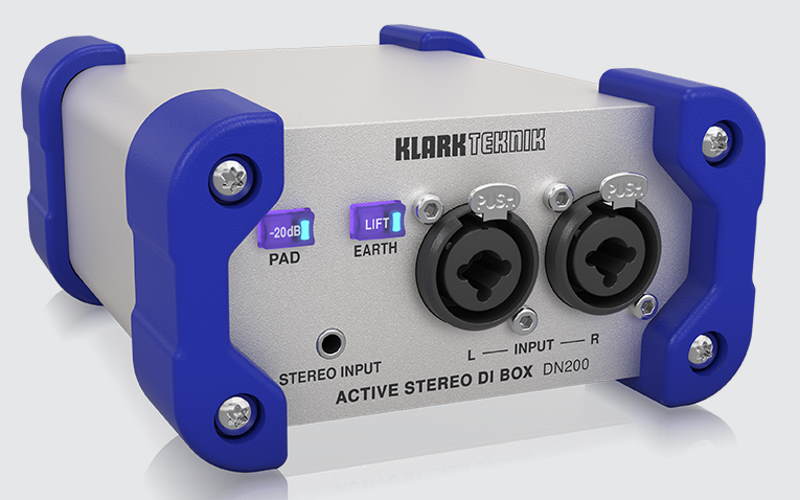KlarkTeknik introduces the DN200 2-Channel Active DI Box
With Extended Dynamic Range and Sum/Split Options

With its high headroom, dynamic response and sonic clarity, DN200 faithfully reproduces the character of electric and acoustic instruments and allows far more of the detail of musical performances to be captured. DN200 is intended for professional applications where +48 V phantom power is a standard feature on all mixing consoles, and its innovative design results in a significantly higher clipping point than many other active DI Boxes, providing +10 dBu output into a 2 KO load. This increased headroom means that much higher-level input signals can be accommodated without the need for an attenuating pad. Combined with a very low noise input circuit topology, DN200 offers a very wide dynamic range, and only requires the -20 dB pad when connecting directly to instrument amplifier outputs or other very high-level signal sources.
DN200 is built to handle the rigours of life on the road, a thick aluminium extrusion protects the electronics, and in turn is protected by tough silicone rubber corners
Exhaustive listening tests using a wide variety of active and passive bass guitars, electro-acoustic guitars and electronic musical instruments were carried out to select the components for DN200 to achieve the best musical sound. Not only was the choice of the audio transformer particularly important in achieving this goal, but the impedances of the surrounding components were also highly critical in getting the best possible performance out of the audio transformer. The line-driving characteristics of the transformer output were carefully optimized to provide the best frequency and phase responses for short and long cables and widely differing line and termination impedances.
Care was taken in the design of the DN200 to avoid audio transformer core saturation and a fixed high pass filter has been included in the signal path to roll off frequencies below those that are musically important. The lowest note on a 5- or 6-string bass guitar is B0 with a frequency of 30.87 Hz, and the lowest note on an 88-key piano keyboard is A0 with a frequency of 27.50 Hz. DN200 still maintains a frequency response of ±0.5 dB at these lowest musical notes.
As well as the transformers in the signal path, DN200 also has a transformer to isolate the power rails to the input circuit from the phantom power supply sourced from the output XLR connector. When used in conjunction with the Earth Lift switch, this full galvanic isolation of input and output interfaces ensures that any risk of earth loops is avoided when taking a direct feed from stage backline equipment.
A custom instrumentation-grade balanced input circuit was designed for the DN200 using advanced analogue design techniques to create the very high input impedance required by passive guitar and bass pickups, whilst keeping the actual component values low to minimize noise. This innovative approach to circuit design produces a very low noise floor, which combined with the high clipping point creates an unrivalled dynamic range in a +48 V phantom powered DI Box.
DN200 features dual parallel-connected combo XLR’s / ¼" TRS inputs. When connecting to the Combo XLR input, the input impedance is 20 kO, ideal for line level equipment and offering even lower noise performance. This input impedance is far too low for guitar and bass pickups and is removed from the circuit when a jack plug is inserted into the Combo ¼" TRS input, resulting in a nominal 1 MO input impedance, ideal for passive electric pickups.
DN200 is also equipped with a Stereo input mini jack which is ideal for connecting MP3 players or mobiles phones etc.
 How to resolve AdBlock issue?
How to resolve AdBlock issue?